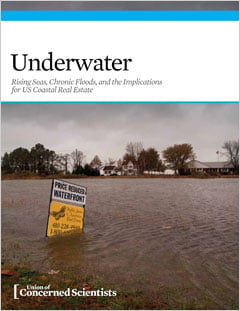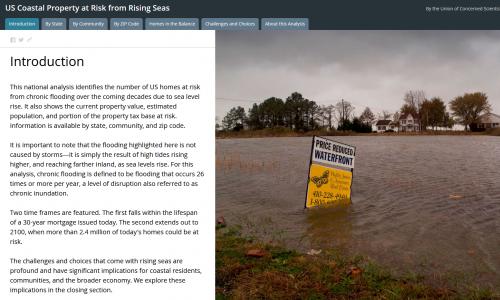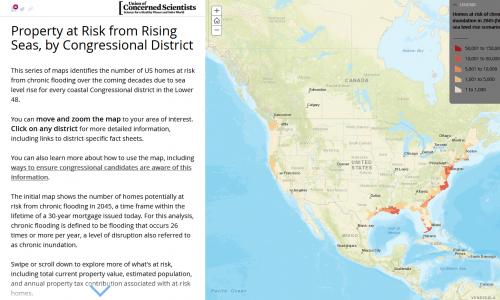Sea levels are rising. Tides are inching higher. High-tide floods are becoming more frequent and reaching farther inland. And hundreds of US coastal communities will soon face chronic, disruptive flooding that directly affects people's homes, lives, and properties.
Yet property values in most coastal real estate markets do not currently reflect this risk. And most homeowners, communities, and investors are not aware of the financial losses they may soon face.
This analysis looks at what's at risk for US coastal real estate from sea level rise—and the challenges and choices we face now and in the decades to come.
We find that:
- More than 300,000 of today's coastal homes, with a collective market value of about $117.5 billion today, are at risk of chronic inundation in 2045—a timeframe that falls within the lifespan of a 30-year mortgage issued today. Approximately 14,000 coastal commercial properties, currently assessed at a value of roughly $18.5 billion, are also at risk during that timeframe.
- By the end of the century, homes and commercial properties currently worth more than $1 trillion could be at risk. This includes as many as 2.4 million homes—the rough equivalent of all the homes in Los Angeles and Houston combined—that are collectively valued today at approximately $912 billion.
- The properties at risk by 2045 currently house 550,000 people and contribute nearly $1.5 billion toward today's property tax base. Those numbers jump to about 4.7 million people and $12 billion by 2100.
- States with the most homes at risk by the end of the century are Florida, with about 1 million homes (more than 10% of the state's current residential properties); New Jersey, with 250,000 homes; and New York with 143,000 homes.
These results reflect a high sea level rise scenario—an appropriately conservative projection to use when estimating risk to homes, which are often the owner's single biggest asset. Even with a more moderate (intermediate) rate of sea level rise, nearly 140,000 homes are still at risk of chronic inundation by 2035 and more than 1.2 million by 2100. (See below for more information about the sea level rise scenarios used in this analysis.)
It is also important to note that these results do not include future development or new homes, nor do they include critical infrastructure such as roads, bridges, power plants, airports, ports, public buildings, and military bases. When all of these are taken together, the effects of chronic flooding could have staggering economic impacts.
About this analysis
To determine the number of coastal properties at risk from this level of chronic flooding, the analysis uses property data from the online real estate company Zillow combined with the findings of the 2017 analysis, When Rising Seas Hit Home: Hard Choices Ahead for Hundreds of US Coastal Communities, which uses a peer-reviewed methodology to assess areas at risk of chronic inundation.
Three sea level rise scenarios, developed by the National Oceanic and Atmospheric Administration (NOAA) and localized for this analysis, are included:
- A high scenario that assumes a continued rise in global carbon emissions and an increasing loss of land ice; global average sea level is projected to rise about 2 feet by 2045 and about 6.5 feet by 2100.
- An intermediate scenario that assumes global carbon emissions rise through the middle of the century then begin to decline, and ice sheets melt at rates in line with historical observations; global average sea level is projected to rise about 1 foot by 2035 and about 4 feet by 2100.
- A low scenario that assumes nations successfully limit global warming to less than 2 degrees Celsius (the goal set by the Paris Climate Agreement) and ice loss is limited; global average sea level is projected to rise about 1.6 feet by 2100.
Disclosure
Data provided by third parties through the Zillow Transaction and Assessment Dataset (ZTRAX). More information on accessing the data can be found at https://www.zillow.com/ztrax. The results and opinions presented in this report are those of the Union of Concerned Scientists and do not reflect the position of Zillow Group.
Disclaimer
This research is intended to help individuals and communities appreciate when sea level rise may place existing coastal properties (aggregated by community) at risk of tidal flooding. It captures the current value and tax base contribution of those properties (also aggregated by community) and is not intended to project changes in those values, nor in the value of any specific property.
The projections herein are made to the best of our scientific knowledge and comport with our scientific and peer review standards. They are limited by a range of factors, including but not limited to the quality of property-level data, the resolution of coastal elevation models, the potential installment of defensive measures not captured by those models, and uncertainty around the future pace of sea level rise. More information on caveats and limitations can be found at www.ucsusa.org/underwater.
Neither the authors nor the Union of Concerned Scientists are responsible or liable for financial or reputational implications or damages to homeowners, insurers, investors, mortgage holders, municipalities, or other any entities. The content of this analysis should not be relied on to make business, real estate or other real world decisions without independent consultation with professional experts with relevant experience. The views expressed by individuals in the quoted text of this report do not represent an endorsement of the analysis or its results.






